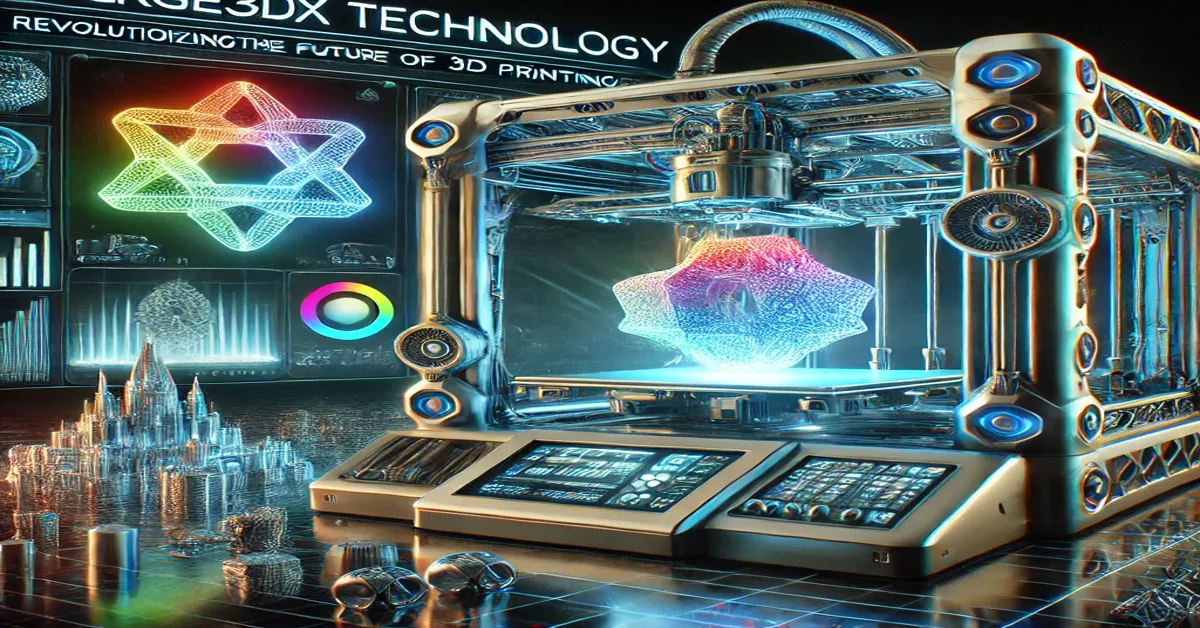The world of 3D printing has advanced by leaps and bounds over the last few decades, transforming industries ranging from healthcare to aerospace. As this technology continues to evolve, new and innovative methods of creating complex designs are emerging, and one of the most prominent of these is Serge3DX technology. This revolutionary approach to 3D printing and design has the potential to reshape how we think about manufacturing, prototyping, and even everyday products.
In this article, we will explore the key aspects of Serge3DX technology, how it works, its applications across different sectors, and the impact it could have on the future of 3D printing. We will also discuss the advantages and challenges of Serge3DX technology, as well as its potential to change how industries approach design and production. To wrap up, we will address some frequently asked questions (FAQs) to help you gain a better understanding of this cutting-edge technology.
What is Serge3DX Technology?
Serge3DX is a groundbreaking advancement in the field of 3D printing that goes beyond traditional additive manufacturing. It incorporates a more dynamic and versatile approach to three-dimensional design and production, allowing for the creation of highly intricate, multi-material, and multi-functional objects with unprecedented precision.
Unlike conventional 3D printing, which primarily focuses on layering materials to form an object, Serge3DX technology takes a more holistic view of the entire design and production process. This system not only improves the way materials are deposited but also integrates smart algorithms, complex geometry handling, and hybrid manufacturing techniques to achieve a much higher level of detail and complexity in the final product.
Key Features of Serge3DX Technology:
- Multi-Material Printing: Enables the use of multiple materials in a single print, combining diverse properties such as strength, flexibility, and conductivity.
- Dynamic Design Adjustments: Allows for real-time adjustments during the printing process, providing flexibility and customization on-the-go.
- Hybrid Manufacturing: Integrates additive and subtractive processes, such as milling or polishing, to create more refined objects with complex geometries.
- Advanced Algorithms: Utilizes machine learning and AI-driven algorithms to optimize designs for functionality, efficiency, and material usage.
How Does Serge3DX Technology Work?
The essence of Serge3DX technology lies in its integration of various advanced tools and methodologies that push the boundaries of 3D printing. Here’s a breakdown of the core elements that make Serge3DX unique:
1. Multi-Material Deposition
One of the defining features of Serge3DX is its ability to print with multiple materials simultaneously. Traditional 3D printers usually work with a single material, but Serge3DX machines can handle a wide range of materials, including plastics, metals, ceramics, and even smart materials like shape-memory alloys or conductive polymers. This allows for the creation of complex, functional objects that would otherwise require multiple assembly steps using conventional methods.
For example, a Serge3DX printer could produce a product with both rigid and flexible parts, or even embed sensors or conductive elements directly into the design without needing additional components.
2. Real-Time Design Adjustments
Another significant innovation in Serge3DX technology is the ability to make real-time adjustments to the design during the printing process. Using advanced sensors and AI algorithms, the system can adapt to changes in material properties, environmental factors, or design specifications on the fly. This capability reduces errors and allows for greater customization without the need to halt production.
This adaptability is especially valuable in industries like aerospace and healthcare, where precision and customization are critical.
3. Hybrid Manufacturing Process
Serge3DX integrates both additive (layer-by-layer printing) and subtractive (material removal) manufacturing processes. After printing an object using additive methods, the machine can automatically switch to subtractive techniques such as milling, cutting, or polishing to refine the final product. This hybrid approach results in a much smoother finish and more precise dimensions than traditional 3D printing alone.
This hybrid capability also opens the door for more complex geometries, such as internal channels or overhangs, that are difficult or impossible to achieve with conventional 3D printing techniques.
4. Advanced Algorithms for Design Optimization
Serge3DX technology employs AI-driven algorithms to optimize the design process. These algorithms can analyze the object being printed and suggest changes that will improve its structural integrity, reduce material waste, or enhance its functionality. For instance, they can automatically adjust the infill pattern of a printed object to ensure that it has the required strength while minimizing material usage.
Additionally, these algorithms can simulate different environmental conditions, such as temperature or mechanical stress, to ensure that the object will perform as expected under real-world conditions.
Applications of Serge3DX Technology
The versatility and precision of Serge3DX technology make it applicable across a wide range of industries. Below are some key sectors that are already benefiting from this technology:
1. Healthcare
One of the most exciting applications of Serge3DX technology is in the healthcare industry. The ability to print with multiple materials and create complex geometries opens up new possibilities for producing medical devices, prosthetics, and even bioengineered tissues. Surgeons can use Serge3DX technology to create patient-specific implants, reducing the risk of complications and improving outcomes.
Additionally, researchers are exploring the potential for Serge3DX to print bioactive scaffolds that could be used in regenerative medicine. These scaffolds, combined with living cells, could one day help repair damaged organs or tissues.
2. Aerospace and Defense
In aerospace and defense, weight reduction and material optimization are critical. Serge3DX technology allows manufacturers to create lightweight, high-strength components that meet the stringent requirements of these industries. The hybrid manufacturing process enables the production of complex, optimized parts with minimal material waste, which is particularly important in sectors where every gram matters.
Furthermore, the ability to print with multiple materials makes it possible to integrate electronic components, sensors, or heat-resistant materials directly into structural parts, reducing the need for assembly and improving performance.
3. Automotive
The automotive industry is always looking for ways to improve performance, reduce costs, and accelerate product development. Serge3DX technology offers a solution by enabling the rapid prototyping of complex parts and the production of custom, lightweight components. Auto manufacturers can use Serge3DX to create optimized designs for engine parts, chassis components, and even interior elements, all with a level of precision and customization that traditional manufacturing methods can’t match.
The real-time adjustment capabilities of Serge3DX are especially valuable in motorsports, where engineers often need to make quick adjustments to vehicle components between races.
4. Consumer Electronics
As consumer electronics continue to shrink in size and increase in complexity, manufacturers need new ways to produce intricate, multifunctional components. Serge3DX technology can print with conductive materials, allowing manufacturers to embed electronic circuits, sensors, and antennas directly into plastic or metal parts. This capability reduces assembly time and allows for the creation of more compact, integrated devices.
Additionally, Serge3DX can be used to produce custom phone cases, wearables, and other accessories with unique designs and functionality.
5. Architecture and Construction
The construction industry is beginning to embrace 3D printing as a way to reduce material waste and speed up the building process. Serge3DX technology offers new possibilities for printing complex architectural elements, such as decorative facades, structural components, or even entire buildings. The multi-material capabilities of Serge3DX also make it possible to integrate insulation, electrical wiring, or plumbing directly into walls and other structures.
In addition, Serge3DX can be used to create detailed scale models of buildings or urban environments, allowing architects and city planners to visualize their designs more effectively.
6. Education and Research
Universities and research institutions are using Serge3DX technology to push the boundaries of science and engineering. The ability to create complex geometries and integrate multiple materials in a single print allows researchers to experiment with new materials, test prototypes, and develop innovative solutions in fields like robotics, nanotechnology, and material science.
In educational settings, Serge3DX provides students with hands-on experience using cutting-edge technology, preparing them for careers in industries that are increasingly reliant on advanced manufacturing techniques.
Advantages of Serge3DX Technology
Serge3DX offers several key advantages over traditional 3D printing methods and other manufacturing techniques:
1. Increased Complexity
Serge3DX technology allows for the creation of highly complex objects that would be impossible or impractical using traditional manufacturing methods. The ability to print with multiple materials and integrate both additive and subtractive processes enables the production of intricate designs with embedded functionalities.
2. Material Efficiency
By optimizing material usage through advanced algorithms, Serge3DX can significantly reduce waste during the manufacturing process. This not only helps lower production costs but also reduces the environmental impact of manufacturing.
3. Customization
The real-time adjustment capabilities of Serge3DX technology make it ideal for producing custom, one-of-a-kind objects. Whether it’s a personalized prosthetic, a custom automotive part, or a unique architectural element, Serge3DX enables manufacturers to quickly and efficiently create tailored solutions.
4. Faster Prototyping
Serge3DX technology accelerates the prototyping process by allowing designers to iterate rapidly and make changes on the fly. This reduces the time it takes to bring a product from concept to reality, giving businesses a competitive edge in fast-moving markets.
5. Hybrid Manufacturing
The integration of additive and subtractive manufacturing processes in Serge3DX machines eliminates the need for separate finishing steps, reducing production time and improving the quality of the final product. This hybrid approach also enables the creation of more precise, detailed objects than is possible with 3D printing alone.
Challenges of Serge3DX Technology
While Serge3DX technology offers numerous advantages, it is not without its challenges. Some of the key obstacles
to widespread adoption include:
1. Cost
The advanced capabilities of Serge3DX machines come at a price. These machines are typically more expensive than traditional 3D printers, making them less accessible to smaller businesses or individuals. However, as the technology becomes more widespread, costs are expected to decrease.
2. Technical Expertise
Operating a Serge3DX machine requires a higher level of technical expertise than traditional 3D printing methods. Manufacturers need to invest in training for their staff to fully take advantage of the technology’s capabilities.
3. Material Limitations
While Serge3DX can print with multiple materials, there are still limitations on the types of materials that can be used. Certain high-performance materials, such as some ceramics or composites, may not be compatible with the technology.
4. Post-Processing Requirements
Although Serge3DX integrates subtractive manufacturing, some objects may still require additional post-processing steps, such as heat treatment or surface finishing, to meet certain performance standards.
The Future of Serge3DX Technology
The potential of Serge3DX technology to revolutionize manufacturing and design is immense. As more industries adopt this technology, we can expect to see significant advances in fields such as healthcare, aerospace, and consumer electronics. In the coming years, we may also see the development of new materials specifically designed for use with Serge3DX, further expanding the range of applications.
Additionally, ongoing advancements in AI and machine learning will continue to improve the efficiency and precision of Serge3DX technology. As these algorithms become more sophisticated, they will be able to optimize designs in ways that were previously unimaginable, leading to even more innovative and functional products.
The rise of Serge3DX could also drive the growth of decentralized manufacturing, where businesses and individuals can create custom products on-demand, reducing the need for large-scale production facilities and long supply chains. This could lead to a more sustainable, efficient, and flexible approach to manufacturing in the future.
Conclusion
Serge3DX technology is poised to transform the world of 3D printing and design. With its ability to handle multiple materials, integrate hybrid manufacturing processes, and optimize designs in real-time, Serge3DX opens up new possibilities for industries ranging from healthcare to aerospace. While there are challenges to its widespread adoption, the benefits of this technology are undeniable, and it holds great promise for the future of manufacturing.
As more businesses and industries embrace Serge3DX, we can expect to see even greater innovation and efficiency in product development, prototyping, and production. By leveraging the power of this advanced technology, manufacturers can create more complex, customized, and sustainable products, reshaping the way we think about design and manufacturing.
FAQs
1. What is Serge3DX technology?
Serge3DX technology is an advanced form of 3D printing that integrates multi-material deposition, real-time design adjustments, and hybrid manufacturing processes to create highly complex, functional objects with precision.
2. What industries benefit from Serge3DX technology?
Serge3DX technology is used in industries such as healthcare, aerospace, automotive, consumer electronics, architecture, and education. Its versatility makes it suitable for a wide range of applications.
3. How does Serge3DX differ from traditional 3D printing?
Unlike traditional 3D printing, which typically uses a single material and focuses on additive manufacturing, Serge3DX can print with multiple materials, make real-time adjustments, and incorporate both additive and subtractive processes for a more refined final product.
4. What are the advantages of Serge3DX technology?
Key advantages include increased design complexity, material efficiency, customization capabilities, faster prototyping, and the integration of hybrid manufacturing processes, which reduces the need for post-processing.
5. What are the challenges of using Serge3DX technology?
Challenges include higher costs, the need for specialized technical expertise, material limitations, and occasional post-processing requirements. Despite these challenges, the technology’s potential benefits are significant.
6. What is the future of Serge3DX technology?
The future of Serge3DX technology is promising, with ongoing advancements in AI, machine learning, and material science expected to further enhance its capabilities and expand its range of applications across various industries.











